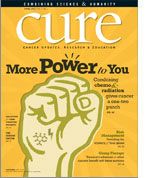Publication
Article
CURE
Do Two Bads Equal One Good?
Author(s):
The number of cancers and scenarios to respond to chemoradiation therapy has grown.
When it comes to cancer, it is often said that the treatment is worse than the disease. While recent advances in many of the therapeutic avenues have lessened side effects and improved effectiveness, chemotherapy and radiation still have the reputation of being the bad boys on the block. Nevertheless, combining these two simultaneously is being recommended more and more. And for good reason. Yes, there are more side effects when these are given together, but they have unique advantages that cannot be gotten any other way (at least for now). In “Dynamic Duo,” you will read about the interesting biology, although not fully understood, that results in what we call synergy—a total effect that is greater than the sum of combining chemotherapy and radiation, known as chemoradiotherapy (CRT), or more technically as “combined modality therapy.”
The number of cancers and scenarios that are now proven to respond more favorably to CRT has grown over the years. Depending on the situation, it may allow for a higher cure rate or the ability to use less or no surgery. But it requires close coordination that starts at the time of the initial decision, which often is made at a multidisciplinary tumor board conference where several specialists contribute to formulating a treatment plan. It also requires careful preparation to minimize side effects and to monitor and intervene as necessary. And the surveillance may need to continue for years, as late effects can sometimes arise.
This feature article is emblematic of a more general theme in cancer care that will become more widely used as we dissect those cellular pathways that cancer cells use to survive and thrive. Combinatorial therapy refers to a biologically precise pairing of two drugs or types of treatments that specifically work well together. Given the complexities and individual nature of cancer, personalized cocktails represent the logical evolution of this concept and are likely to become commonplace. However, the ability of radiation to focus on a specific anatomic site makes this a valuable tool for specific settings. The field of radiobiology now constitutes an important area of ongoing research as newer partner drugs undergo study.






